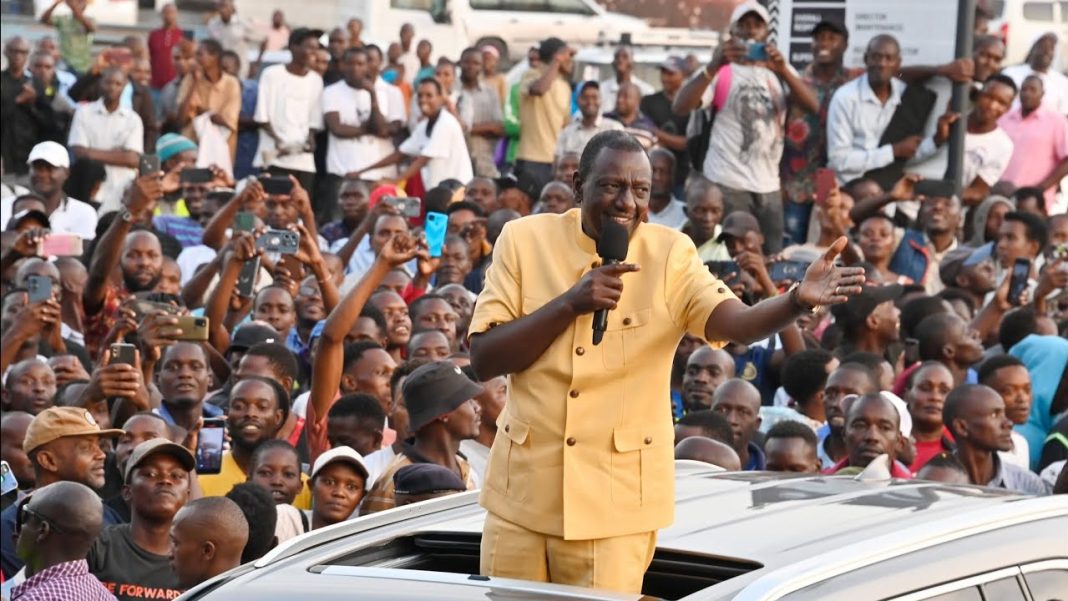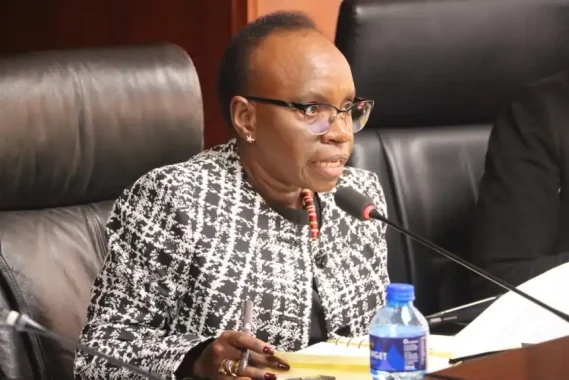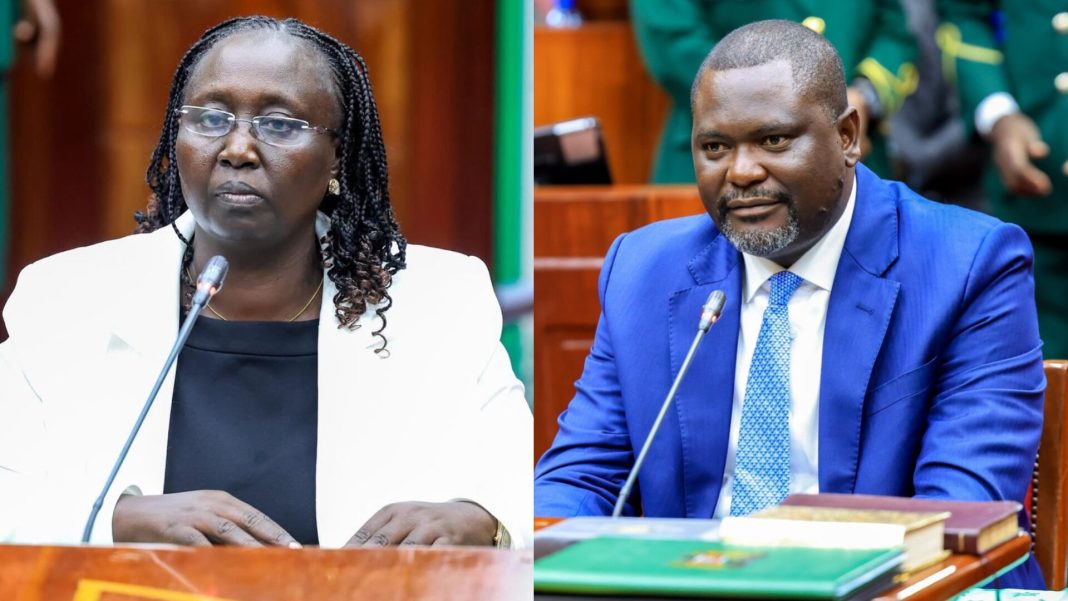President William Ruto has found himself at the centre of a political storm, facing endless criticism from various quarters. In response, he has taken a firm stand, repeatedly asserting his competence and rationality. His now-famous declaration, “I am not a mad man,” has become a defining phrase in his speeches, symbolizing his frustration with the unyielding doubt surrounding his administration.
This statement, often delivered with a mix of seriousness and judgement, appears to be a direct argument to the growing chants of “Ruto must go,” which have become a rallying cry for his critics. These chants, echoing persistently at public events, reflect the dissatisfaction of a segment of the population with his policies and leadership style. However, President Ruto has not shied away from addressing these criticisms head-on. He has emphasized that his administration is committed to fulfilling its promises and delivering tangible results for the Kenyan people.
In his speeches, Ruto has also called for an end to personal attacks and insults, urging his critics to focus on constructive dialogue. “Quit the insults,” he has said, highlighting the need for a more respectful and solution-oriented approach to addressing the nation’s challenges. This plea for civility underscores his belief on the importance of unity and collaboration in overcoming Kenya’s socio-economic hurdles.
Despite the criticism, Ruto remains steadfast in his vision for the country. He has outlined ambitious plans to revitalize key sectors such as education, healthcare, and agriculture. His administration has also prioritized initiatives aimed at reducing the cost of living and creating job opportunities for the youth. These efforts, he argues, are evidence of his commitment to the well-being of all Kenyans.
The president’s frequent defense of his sanity and competence has sparked both curiosity and debate. While some view it as a sign of his determination to silence detractors, others see it as an indication of the immense pressure he faces in navigating the complexities of leadership.
By Grace Githinji







Can you be more specific about the content of your article? After reading it, I still have some doubts. Hope you can help me.
Hi there, I desure to subscribe for this weblog to gget newest updates, therefore where can i do it please help. https://Glassi-Freespins.Blogspot.com/2025/08/how-to-claim-glassi-casino-free-spins.html
buy facebook ads manager account marketplace account trading platform
facebook ads account buy sell account database of accounts for sale
tiktok ads agency account https://buy-tiktok-ads.org
buy tiktok business account https://buy-tiktok-business-account.org
tiktok ads agency account https://tiktok-ads-agency-account.org
tiktok ads account buy https://buy-tiktok-ads-accounts.org
buy tiktok ad account https://buy-tiktok-ad-account.org
buy tiktok ads tiktok ads account buy
tiktok agency account for sale https://tiktok-ads-account-for-sale.org
tiktok ads account for sale https://tiktok-ads-account-buy.org
buy tiktok ads accounts https://buy-tiktok-ads-account.org
facebook bm account buy-business-manager-accounts.org
buy business manager https://verified-business-manager-for-sale.org/
facebook bm buy buy facebook verified business manager
buy business manager account https://buy-business-manager-verified.org
buy facebook bm account https://business-manager-for-sale.org/
facebook bm account buy buy facebook business manager accounts
buy facebook business manager account buy-verified-business-manager-account.org
buy verified facebook business manager account buy business manager
facebook verified business manager for sale https://buy-bm-account.org
buy verified google ads accounts https://buy-verified-ads-account.work
buy facebook ads accounts and business managers https://buy-business-manager.org
buy google ad threshold account https://ads-agency-account-buy.click
buy account google ads https://sell-ads-account.click
buy old google ads account buy google ads threshold accounts
sell google ads account https://buy-account-ads.work/
buy google ad threshold account buy-ads-invoice-account.top
buy account google ads buy google ads account
buy google ad threshold account https://ads-account-for-sale.top
buy old facebook account for ads buy ad account facebook
buy verified google ads accounts buy google ad account
google ads reseller google ads account buy
buy facebook accounts https://ad-accounts-for-sale.work/
facebook ad accounts for sale facebook accounts for sale
facebook ad account for sale fb account for sale
buy fb ad account buy facebook advertising
facebook ads account for sale buy facebook account
buy facebook old accounts https://buy-ads-account.click
cheap facebook advertising account buy facebook ads account
facebook ad account buy facebook ad account for sale
buy fb ads account https://buy-adsaccounts.work
продать аккаунт https://kupit-akkaunt.online/
маркетплейс аккаунтов соцсетей akkaunty-dlya-prodazhi.pro
маркетплейс аккаунтов online-akkaunty-magazin.xyz
магазин аккаунтов магазины аккаунтов
покупка аккаунтов магазины аккаунтов
маркетплейс аккаунтов https://akkaunty-market.live
продажа аккаунтов https://akkaunt-magazin.online
биржа аккаунтов магазины аккаунтов
биржа аккаунтов rynok-akkauntov.top
маркетплейс аккаунтов соцсетей https://akkaunty-na-prodazhu.pro/
website for selling accounts https://accounts-marketplace-best.pro/
find accounts for sale https://accounts-marketplace.online
guaranteed accounts https://social-accounts-marketplace.live
account exchange https://buy-accounts.live
guaranteed accounts account market
account purchase accounts marketplace
buy and sell accounts https://social-accounts-marketplace.xyz
account buying platform https://accounts-marketplace.live
account trading service https://social-accounts-marketplaces.live/
accounts marketplace https://buy-best-accounts.org
buy account https://accounts-marketplace.xyz/
accounts for sale buy accounts
social media account marketplace sell account
account trading https://shop-social-accounts.org/
account market buy accounts
account store account trading
website for selling accounts secure account sales
account market https://sale-social-accounts.org
sell account account acquisition
buy pre-made account buy and sell accounts
account purchase verified accounts for sale
sell account marketplace for ready-made accounts
buy pre-made account account market
account trading platform social-accounts-marketplace.org
purchase ready-made accounts social media account marketplace
buy pre-made account https://accounts-for-sale.org/
account purchase sell account
account trading platform find accounts for sale
account market account trading service
profitable account sales account selling service
account trading database of accounts for sale
account selling service sell accounts
accounts marketplace account purchase
buy account account store
account buying service buy and sell accounts
account catalog buy pre-made account
account selling service account selling service
website for buying accounts secure account purchasing platform
online account store secure account sales
database of accounts for sale sell pre-made account
Gaming account marketplace Sell Account
Find Accounts for Sale buyaccounts001.com
Account Buying Platform Buy accounts
Marketplace for Ready-Made Accounts Account Trading Service
Account Trading Service Database of Accounts for Sale
Accounts marketplace Database of Accounts for Sale
Account Buying Platform Ready-Made Accounts for Sale
Account Purchase Account Exchange Service
Account Selling Platform Account Trading Service
Account Buying Platform Website for Buying Accounts
биржа аккаунтов магазин аккаунтов социальных сетей
продажа аккаунтов магазин аккаунтов социальных сетей
покупка аккаунтов магазин аккаунтов
продать аккаунт магазин аккаунтов
магазин аккаунтов маркетплейс аккаунтов соцсетей
маркетплейс аккаунтов купить аккаунт с прокачкой
маркетплейс аккаунтов услуги по продаже аккаунтов